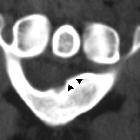Pronator-teres-Syndrom

Pronator teres syndrome (also called pronator syndrome) is one of three common median nerve entrapment syndromes; the other two being anterior interosseous nerve syndrome and the far more common carpal tunnel syndrome. Signs and symptoms result from compression of the median nerve in the upper forearm .
Epidemiology
Pronator teres syndrome is rare. Women over the age of 40 are more frequently affected.
Clinical presentation
Patients may present with :
- volar pain of the proximal lower arm
- paresthesia of the volar forearm and the radial three digits and radial aspect of the fourth digit
- weakness, on the other hand, is variable, often with unspecified grip clumsiness
- the proximal volar forearm is painful to palpation, and Tinel’s sign can be elicited on palpation of the pronator teres muscle
- simian hand deformity: unable to move the thumb away from the rest of the hand
- benediction sign: when trying to form a fist, due to weakness in flexion of radial sided digits
Symptoms provoked by examination maneuvers, such as during resisted forearm pronation (suggesting median nerve compression by pronator teres muscle), or resisted elbow flexion and forearm supination (indicating median nerve compression by biceps aponeurosis / lacertus fibrosus) can help pinpoint the site of compression.
Clinical presentation can harbor some pitfalls. Sensory and pain symptoms of PTS and carpal tunnel syndrome can overlap: distinguish the two by looking for numbness of the forearm, which does not occur in CTS, and asking about nocturnal exacerbation, which would atypical in PTS. Provocation tests as detailed above can help further.
Pathology
The median nerve can be involved at several locations around the elbow :
- distal humerus: avian spur and ligament of Struthers
- proximal elbow: thickened biceps aponeurosis
- elbow joint: between humeral and ulnar heads of the pronator teres muscle ( most common cause)
- proximal forearm: thickened proximal edge of the flexor digitorum superficialis muscle
- Gantzer muscle
Distribution
In complete pronator teres syndrome, affected muscles are the pronator teres (PT), flexor carpi radialis (FCR), palmaris longus (PL), flexor digitorum superficialis (FDS), along with muscles innervated by the anterior interosseous nerve.
Radiographic features
Ultrasound and MRI are the two imaging modalities which best lend themselves to investigating entrapment syndromes. Next to directly visualizing direct causes [e.g. primary nerve or sheath tumors, ganglion cysts, osseous spurs, anatomical variants (e.g. Gantzer muscle), recognizing pathological muscle signal patterns on MRI can inversely point to the affected nerve.
MRI
Look for the pattern of muscle signal changes on fluid-sensitive (STIR, PD, or T2W fat sat) sequences to uncover the affected nerve.
In PTS, the pronator teres (PT), flexor carpi radialis (FCR), palmaris longus (PL), flexor digitorum superficialis (FDS) will reveal hyperintense signal changes secondary to denervation edema, which can occur 24-48 hours after an inciting event; electromyography, the most sensitive neurophysiological study for inferring denervation syndromes, needs 7-14 days to show pattern changes.
Treatment and prognosis
Conservative treatment may be effective in 50–70% of cases with extremity rest and non-steroidal anti-inflammatory drugs. Corticosteroids have also been used. Surgical decompression is indicated in space-occupying lesions and failure of conservative treatment over 12 weeks, with success rates of up to 90% .
Differential diagnosis
Pronator-teres syndrome must be differentially diagnosed from:
- other median nerve entrapment syndromes
- cervical radiculopathy
- thoracic outlet syndrome
- brachial plexus neuritis (Parsonage-Turner Syndrome)
See also
- median nerve entrapment syndromes
- pronator teres syndrome
- carpal tunnel syndrome
- anterior interosseous nerve syndrome
Siehe auch:

 Assoziationen und Differentialdiagnosen zu Pronator-teres-Syndrom:
Assoziationen und Differentialdiagnosen zu Pronator-teres-Syndrom:




